Muscles can do one of two things, either contract or relax, with varying degrees of both. Muscle control is the art of controlling your muscles. More specifically it involves controlling muscles in isolation, in combinations and sequences.
As a specific practice it was largely “created” by Maxick (born Max Sick, but changed his name as Sick is not the best name to go by for someone teaching health), though of course people have been doing it for a long time before the late 1800‘s.
Maxick became a professional weight lifter setting many records, including being the first person to do an overhead jerk with more than double his bodyweight (322 ½ lbs at 145 lbs). Although he lifted weights, he always claimed that that was just to show what his muscles could do, and he maintained that muscle control as a practice was the best means to health and strength.
John Davies, the great Olympic Lifter wrote in an article that “Maxick was the man who appealed to my eye over all others.”
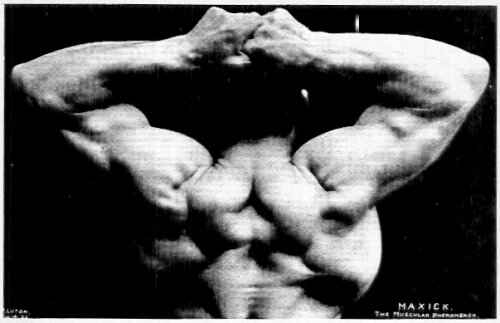
Maxick showing muscular control of the scapula, considered some of the most difficult stunts to do.
John Grimek, regarded as one of the greatest bodybuilders of all time, and an amazing lifter, said that he wouldn’t include muscle control in his acts, despite being quite good at it, because “he could not hope to equal the muscle control of Maxick.”
Maxick is most famous for his book Muscle Control, though there are several others on the subject. He got involved with Monte Saldo to form the Maxalding system and had many pupils. Monte called muscle control “The Language of the Muscles”.
Muscle Control Greats and Videos
Otto Nowosielsky (Otto Arco) was a strongman from Poland, most famous for his wrestling skills and incredible muscle control ability. Apart from that, Otto was an accomplished hand balancer who often practiced with his brother Pete, as seen in the video below from 1930’s.
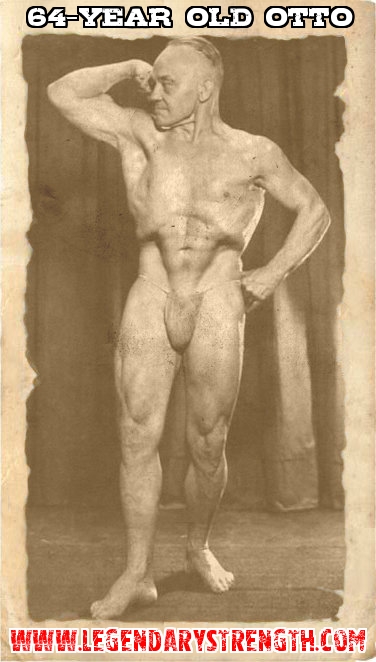
Otto Arco still looking damn good and strong at age 64
John Farbotnik, Mr. America 1950 was also among those who mastered muscle control. His ability to control almost every muscle in his body is still very impressive. In a single video below, Farbotnik shows outstanding control of his pectorals, trapezius, triceps, various back, abdominal and leg muscles. Though muscle control isn’t big in fitness as a means of health and strength anymore, it has a twin, posing. Posing, as is done by bodybuilders, is all about muscle control, though certain elements of the practice were discarded.
People usually wouldn’t think of Eugen Sandow as of someone who practiced muscle control, but indeed he did and that’s before big names like Maxick, Monte Saldo and Otto Arco. Eugen Sandow is considered to be the father of modern bodybuilding and with that title he had to learn how to control his muscles well. Check out this rare footage from 1894 shot by Thomas Edison to see Sandow in action.
This next video is a compilation of muscle control clips, primarily by Tony Holland. He was a bodybuilder from the United Kingdom who specialized in muscle control and won “Opportunity Knocks“, a UK games show, six times in a row. One of his appearances on this shows starts at 2:38.
The Theory Behind Muscle Control
Maxick says that with muscle control exercises you conserve energy, while all apparatus will dispel it. According to his books he tried all manner of other forms of exercise and none gave him the results that muscle control did.
There’s also a theory as to why Maxick and others were so strong. In any lift you’re going to contract some muscles. Pavel teaches about irradiation where you tense every muscle to become stronger. For example, squeezing your opposite fist while doing a press. This does work to some degree as it allows the working muscles to contract harder. But if you’re pressing with your triceps and the biceps contract, they antagonize the movement. Tension in the biceps needs to then be fought. However, if you just tense everything that should be tensed, and relax all those that shouldn’t be you should be better able to exert your maximum strength.
Tensing everything is like putting the gas and brake pedals to the floor. This is how you can do dynamic tension exercises, ala Charles Atlas, resisting yourself, even without the other arm involved. But if you can take your foot off the brake you’ll instantly be stronger. However, this can be harder than it sounds.
The key that everyone in muscle control points out is that the hard part is not contracting, that’s easy. The more difficult part, and the one in which you must focus, is relaxation.
Most exercises also involve certain sequences of muscles firing and relaxing, so having more control of these will also help. Thus with muscle control you gain better command of your muscles, and thus in the end will become stronger.
That all being said I don’t think you can get the best results with ONLY muscle control. But it is something worth exploring.
Abdominal Vacuum
One of the most popular muscle control exercise is the abdominal vacuum. You see examples of this in the video above as well as more advanced variations. Not only does it look great, but it provides multiple health benefits as well. If you were to do only one muscle control exercise this would be it.
It clears out your lungs, as the amount of air expelled from them during this exercise is much greater than when you breathe out normally. Furthermore, your internal organs get a special kind of a massage which couldn’t be done in any other way.
As this exercise helps with keeping you regular, I’d recommend you do it exclusively on an empty stomach. It can be uncomfortable otherwise.
The Rope and Advanced Controls
When you do the vacuum then contract the abdominal rectus you achieve what is called “the rope”, as your abs take on an appearance similar to a rope. This can go even further with single sided isolation of the abs. This is something I’m currently working on and gaining some mastery over.
Just how far can muscle control be taken? Very far. Below is a famous photo of Professor J. Chandrashekhar doing the abdominal vacuum while tensing two of the tendons, and only these tendons. I guess this moves beyond muscle control into tendon control.
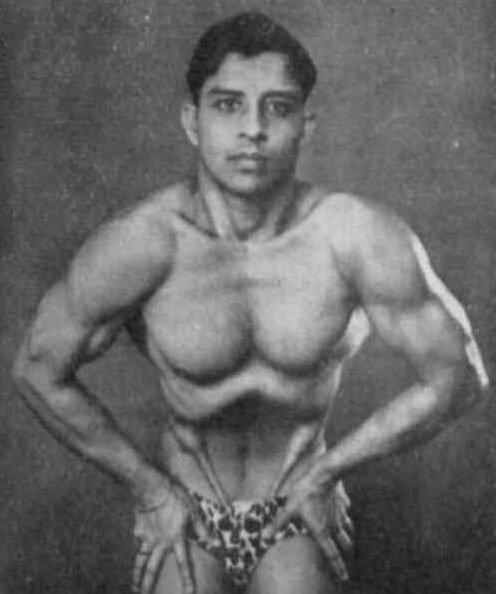
What if your entire body could respond in this manner?
Here are the comments by Court Saldo (Monte Saldo’s son) on this amazing control:
This isolation of an abdominal tendon as demonstrated by Prof. J. Chandrashekhar indicates an extremely high degree of muscle control. The aponeourosis of the obliquus abdominis group is normally obscured by surface muscle. Most of the fibrous tissue of the abdominal wall is concealed or appears in the form of grooves between the muscle groups. The ability to relax the abdomen so completely that a tendon can be brought into hold relief in this way must come as the result of much practice and a very sensitively balanced “muscle sense”. Naturally there must be muscular contraction to bring sufficient tension to the tendon to produce this result, for the tendon has not contractile power of its own. it will be seen that the external oblique muscle (which here appears as a thickening at the top of the tendon), is in contraction and so keeping the tendon taut.
In controls such as the Central Isolation and the Single Sided Isolation of the Rectus abdominis, the external oblique muscles are relaxed. Here the process is reversed, with relaxation of the former and contraction of the latter. But the performance is not quite as simple as the and demands several supporting factors, including extreme refinement of the abdominal tissue and complete freedom of any adipose tissue, and, at the time of performance, an empty stomach and intestine. These photographs of Prof. Chandrashekhar, and others that I have seen, leave us in no doubt as to his great ability as a muscle controller and show a splendidly developed physique.
Simple Biceps Control
The following shows you how to do a simple biceps control. It comes from Muscle Control by Maxick. As the bicep is the muscle focused on by every adolescent boy (and just about everyone else too) you’ll find it’s an easy control to learn.
“Bend the body forward, holding the elbow almost at right angles to the body. Contract the biceps as shown in Fig. 44. Note well that the shoulder is dropped low and the upper arm and elbow pushed well away from the body. This position secures a magnificently full and powerful contraction of the biceps without much effort. The elbow may be lifted even further from the body, and the shoulders dropped still lower. This position will enable the student with a well developed arm to make the forearm and biceps meet. In Fig. 45, a similar position of the arm is shown as in Fig.44, but the biceps is shown full instead of in profile.”
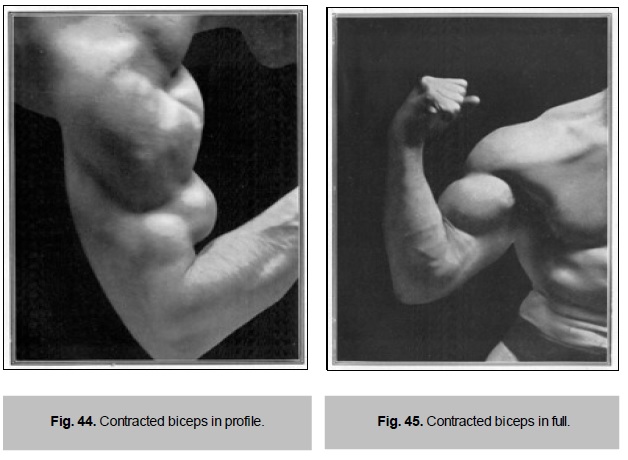
With practice you can not only flex your biceps stronger but get it to bounce between contraction and relaxation, either singly or both at the same time, as was shown in a few of the videos above.
Additional Resources
There are many great books on the subject. What I found amazing is that no one every developed a video course on the subject. So I did. This comes with all of the following books, from many of the greats listed above, a follow along training CD and videos covering the exercises and other ways to use muscle control.
You can check out my muscle control course here.
As for the books themselves, I’ve written a little about each one here. These can be found for free online in a few places but I’ve also had them republished in paperback copy for those that like real books, as I do and not to stare at a computer screen anymore than I already do.
1. Muscle Control by Maxick
The classic book on the subject. After an introduction to his life story and how he came to develop muscle control Maxick shares 21 exercises, plus variations, with 50 photos.
2. How to Learn Muscle Control by Otto Arco and Alan Calvert
Originally from a collection of magazine articles this is one of my favorite books on the topic. Otto Arco demonstrates the exercises, giving details, though it is largely written by the author of Super Strength, Alan Calvert. Gives you details you won’t find anywhere else with lots of specifics on doing the muscle controls.
3. Maxalding by Monte Saldo
Covers much more than just the exercises, this lays out many of the principles behind the Maxalding system including breathing, diet, nutrition, hygiene and more. This was featured in the Physical Culture Book Club so you can read many more details about it here.
4. The Why and How of Muscle Control by Court Saldo
Another collection of magazine articles, this short book was written later than many of the others, so it includes new details along with many exercises, and stories about Maxick and Monte.
5. Great Strength by Muscle Control by Maxick
In this book you learn how to apply what you learn from muscle control into how to lift weights. Shows tons of the classic weight lifting exercises like the snatch, clean, one arm jerk, bent press, swing, military press, anyhow and more.
6. The Art of Muscle Control by Tom Woodward
Another great one on muscle control. This book lays out three months of training, with new exercises for each month. Not just muscle control but it also includes calisthenics and exercises similar to Charles Atlas’ dynamic tension.
7. How to Become a Great Athlete by Maxick
More of a behind-the-scenes book. While it shows a few exercises and results of students, its more about Maxick’s philosophy and beliefs than anything else. This of course is very important stuff which he ties into what he does for strength and athleticism.
8. Health, Strength & Will Power by Maxick & Monte Saldo
More of a promotional booklet for their other courses than a training manual itself. Covers the benefits and shows results of students.
9. Muscle Flexing by Antone Matysek
I don’t know if it was purely a rip-off or there was some sort of deal made. This book is a blatant copy of Maxick’s Muscle Control with a couple sentences changed and different photos.
Questions about muscle control? Comments? Share below…

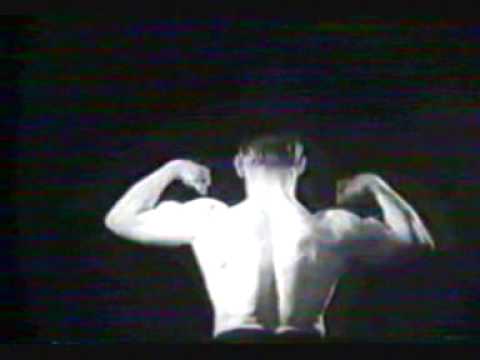
Comments
The tendon activation that Chandraskekar displays is is simply a matter of adjusting the position of the ribcage while holding the exhale. Try sliding the ribcage back a little and at the same time creating a downward pull on the bottom front corners of the ribcage. As for the biceps flexing instructions, pushing the shoulder down and forwards helps to stabilize the scapulae which then give both the biceps and the triceps a stable foundation from which to activate, making it easier to tense the biceps (and the triceps.)